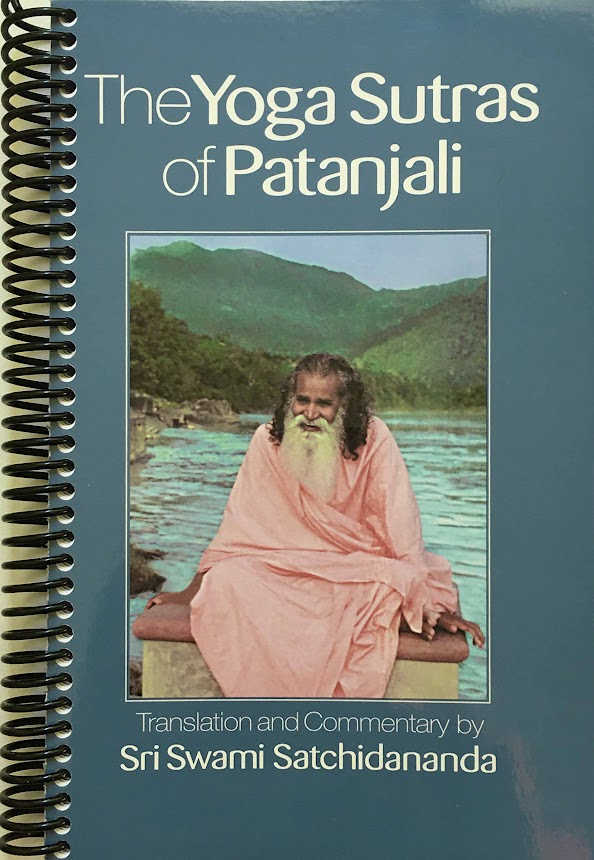The Yoga Sutras of Patanjali (1978) stand as a timeless guide on yogic ideology and application. Originating in ancient Sanskrit, it elucidates the central metaphysical, spiritual, psychological, ethical, and moral concepts of yoga. Furthermore, it elucidates the methodologies for engaging in yoga, enabling individuals to implement these notions and leverage them to attain enduring joy and inner serenity.
- Commencement: Grasp the authentic essence of yoga
- Sri Swami Satchidananda explicates the Yoga Sutras in a manner inclusive to individuals of all spiritual orientations
- Implementing yoga yields tangible outcomes confirmable through personal encounters
- Yoga doctrine instructs you to cease identifying solely with external entities — including your mind and body.
- The Genuine Self is spirit, and the identical spirit is within everyone and everything
- As Prakṛti, the intellect is a distorted, egotistic reflection of Puruṣa
- Unawareness of the Genuine Self leads to egotism and suffering
- Engaging in yoga cultivates your mind serene and transparent so you can perceive the Genuine Self
- Yogic practice encompasses an assortment of physical and mental drills that facilitate you attain a spiritual condition termed Samādhi.
- Final Summary
- About the author
Commencement: Grasp the authentic essence of yoga
When you envision the term “yoga,” what initially springs to mind? For many in the contemporary Western world, it likely revolves around images of physical stretching.
However, delving into yoga’s age-old Eastern heritage reveals that it transcends mere physical exercise. Rooted in history for millennia, it embodies a spiritual philosophy and practice promising self-evolution and spanning varied themes: psyche and physique, ethics and virtue, and metaphysics and psychology, among others.
While yoga may seem somewhat abstract as a philosophy, it boasts a pragmatically grounded practice. It delineates a direct, methodical route to achieving inner harmony and delight, guiding individuals on surmounting hurdles encountered along their journey.

Sri Swami Satchidananda explicates the Yoga Sutras in a manner inclusive to individuals of all spiritual orientations
Estimated to have been compiled between 500 BC and 300 AD, an Indian sage named Patañjali delineated the fundamental tenets of yoga through a series of 196 succinct aphorisms, known as sutras in Sanskrit. Thus emerged the Yoga Sutras of Patañjali.
This constitutes one of the primary ancient yoga texts. Hence, if you seek insight into yogic philosophy and practice, this represents a natural starting point. However, a solitary predicament exists: the style of its composition.
Each sutra embodies a concise, intricate, and often enigmatic sentence or fragment. Several lack explicit subjects and predicates, with some scholars attributing this to these being shorthand notes from Patañjali’s lectures. Consequently, the sutras necessitate meticulous translation and interpretation.
Enter Sri Swami Satchidananda, an Indian yoga luminary of the twentieth century.
The crux of the matter lies in: Sri Swami Satchidananda explicates the Yoga Sutras in a manner inclusive to individuals of all spiritual orientations.
In youth, Satchidananda studied agriculture, science, and technology, yet he eventually abandoned these pursuits, dedicating himself to yoga. For years, he regarded the Yoga Sutras as the guiding beacon of his spiritual expedition. During the late 1970s, post attaining international acclaim as a yoga maestro, he opted to craft his unique translation and interpretation of the Sutras, aiming to make them accessible to a religiously diverse contemporary populace.
Presently, the Sutras stand as a Hindu scripture. Nevertheless, Satchidananda did not associate himself with Hinduism or any specific creed. He perceived yoga as merely one of myriad channels to convey, comprehend, and apply the fundamental truths present in other religions and spiritual doctrines such as Buddhism, Judaism, Christianity, and Islam.
Reflect upon the term yoga itself. In Sanskrit, “yoga” signifies “union.” Through yoga practice, seekers aim to realize union — prompting the inquiry: Union with what? Much like diverse global spiritual traditions, Satchidananda delineates this entity with various designations: God, Puruṣa, Atman, Īśvara, the Seer, and the cosmic mind, among others. Nonetheless, to him, the label holds minor significance; the underlying verity reigns supreme.
And this verity? Ultimately transcending linguistic bounds, it entails the notion of an entity, essence, principle, awareness, existence, or vigor lying beyond and materializing within the worldly realm.
Attribute any name you wish. The essence is to acknowledge it, fuse with it, and allow its authority to metamorphose you.
Implementing yoga yields tangible outcomes confirmable through personal encounters
A rigorous scientific outlook might find the discussions on God, the cosmic mind, or any mystical element hypothesized as fundamental to the universe somewhat off-putting.
However, contemplate this: If a scientist asserted that everything essentially manifests as energy in varied forms, would the notion of an underpinning entity in the universe appear more plausible?
If so, and if the term “energy” resonates with you, embrace it. Satchidananda does not mandate allegiance to any particular lexicon, credo, or collection of concepts for depicting, elucidating, or comprehending the universe. Instead, he encourages utilizing yoga as a mechanism for self-transformation and reshaping your interaction with the universe. Here, akin to scientific endeavors, the primary concern is yielding verifiable outcomes.
The fundamental idea is: Implementing yoga yields tangible outcomes confirmable through personal encounters.
In Satchidananda’s perspective, the philosophical notions and scriptures of yoga solely cater to the intellect’s realm. They represent endeavors to articulate the ultimately ineffable truths regarding the self and the universe. Nevertheless, according to these very ideas and scriptures, realizing this truth surpasses mere cogitation or perusal; it necessitates direct encounter.
At this juncture, yoga practice steps in. Comprising eight elements: abstinence practice, observances, posture regulation, breath mastery, sense management, concentration, meditation, and contemplation. While we shall delve into each of these components later, currently, the essence is merely practicing them, intended to furnish or equip you to cultivate experiences of the truth.
And what do these experiences and truths entail? Spanning back to the essence of the term “yoga”: uniting with God, the cosmic mind, or whatever appellation resonates with you for that mysterious entity underpinning the universe. This unity constitutes the experience, and the existence of that underlying entity stands as the truth.
Per Satchidananda, Patañjali, and other yogis, realization of this truth bestows transformative joy and tranquility, with yoga practice serving as a conduit to attaining this experience. However, you need not merely accept their assertions: experience it firsthand and witness the impacts.
Yoga doctrine instructs you to cease identifying solely with external entities — including your mind and body.
You might currently harbor an eagerness to immediately plunge into yoga practice, for after all, that represents its quintessence in the final analysis.
Yet, to intellectually fathom yoga practice, comprehending its philosophical underpinnings beneficially precedes it. This philosophy may vary contingent on your background and sensibilities, yet it constitutes a potent scaffold.
may appear a bit obscure — but don’t dwell on it. Consider it akin to a staircase: it is helpful for reaching the summit of something, but once you reach your destination, you can leave it behind.
The essence of the ideology of yoga is to assist you in adopting the discipline. Once you achieve that, you can conclude it, if you wish.
The primary idea is this: The ideology of yoga instructs you to cease associating yourself with external things — encompassing your mind and body.
The simplest approach to comprehend the ideology of yoga is to commence with oneself. Who or what are you? Various responses might come to mind. “I’m a man or woman, parent or caretaker, attorney or physician. I’m petite or lofty, affluent or impoverished, dark-skinned or fair-skinned,” or whatever the situation might be.
However, here’s the issue. All these terms convey notions your mind holds about specific facets of your body, your existence, or your interactions with other individuals or entities.
When stating things like “I am a guardian” or “I’m affluent,” individuals are essentially linking themselves with their perceptions regarding those other entities. Nevertheless, in reality, they are not those entities. A mother is not her child. A wealthy individual is not their bank account. Thus, these associations are fallacious.
If you eliminate all your erroneous associations, what remains? “Well, then I’m merely my physique or my intellect,” you might express. However, observe your terminology here: my physique, my intellect. These are entities that pertain to you — a physique and intellect you can observe. But to whom, precisely, do they belong? And who is observing them?
Indeed, you are! This implies you can’t be your physique or your intellect either, so there must be something else that constitutes the genuine you.
Yet, what’s left?
The Genuine Self is spirit, and the identical spirit is within everyone and everything
Contemplate it akin to a mathematical equation: Subtract your physique, your intellect, and everything else that’s extrinsic to you — elements like your job, riches, gender, and so forth. What remains? Well, there’s solely you. To articulate it more philosophically, all that’s left is the unadulterated “I,” cleansed of all fallacious associations with everything that’s not your essential self — that is, non-self. Let’s deem this unadulterated “I” the Genuine Self.
This principle applies to every other individual as well. Bereft of erroneous associations, each of them is also merely a pristine “I.” For them, that’s the Genuine Self as well.
Nevertheless, hold on — if the Genuine Self of both you and your peers is merely a pristine “I” that can’t be distinguished regarding anything you’d conventionally employ to identify individuals, how can you distinguish between you and them?
Well, you can’t — that’s exactly the essence!
The essential message here is: The Genuine Self is spirit, and the identical spirit is within everyone and everything.
If the Genuine Self underlying your intellect and body can’t be discriminated from the Genuine Self underlying everyone else’s intellect and body, they must be the same entity. The essence of that entity defies language, but to converse about it, we need to assign it a title. “Genuine Self” is one. “Spirit” is another.
Now, the same reasoning can be extended further to all sentient beings and even lifeless objects. Select anyone or anything within the cosmos, deduct the attributes with which your intellect improperly associates it, and ultimately, all you’re left with is another Genuine Self or spirit, which cannot be differentiated from any other.
Thus, the identical spirit pervades everyone and everything in the corporeal universe — from humans to canines to stones. Beneath all of their external variances, all these entities and beings are fundamentally the same Genuine Self.
In the Sanskrit vocabulary of yogic philosophy, the entirety of the corporeal universe is labeled Prakṛti. It encompasses everything you’d usually categorize as material, like everyday items and bodies. However, it also encompasses your intellect, which yogic philosophy perceives as simply the consequence of materialness assuming an exceptionally subtle, intricate form.
The Genuine Self or spirit underlying Prakṛti, in turn, is referred to as Puruṣa. The relationship between Prakṛti and Puruṣa is at the core of yogic philosophy. And as we’ll witness, it’s also the juncture at which that philosophy transitions into practice.
As Prakṛti, the intellect is a distorted, egotistic reflection of Puruṣa
“Nevertheless,” a doubter might object. “That still fails to answer the query, ‘What is the Genuine Self?’ Certainly, it can be ascribed other designations, like ‘spirit,’ and it’s the same spirit in everything and everyone — but what precisely is it?”
Excellent query — and the mere fact that you might sense a necessity to question it poses a predicament in itself. If the Genuine Self exists, how can you even be pondering what it is? After all, if you are the Genuine Self, then presumably no one should be more knowledgeable about what it is than you! So why the enigma? And why do individuals usually link themselves with things that aren’t the Genuine Self?
To address these inquiries and resolve this apparent anomaly, you need to delve into one of the profoundest layers of yogic philosophy.
Here’s the primary message: As Prakṛti, the intellect is a distorted, egotistic reflection of Puruṣa.
Visualize the intellect as the facade of a lake. If you observe it, you discern a reflection of various entities, encompassing the other components of your body, of which your intellect is merely a component. They also encompass the other beings and objects of Prakṛti, or the entire material universe, which the intellect discerns through the body’s senses, and of which it is likewise merely a part.
Now, contemplate what occurs to the facade of a lake when it’s agitated by something like mire or zephyr — it turns turbid or rippled. In that scenario, its reflections become distorted, akin to those of a funhouse looking glass.
A parallel event transpires to the intellect. Pessimistic thoughts, sentiments, cravings, attachments, and erroneous convictions fill the intellect with turmoil and impurities. These render the intellect’s “mental water” murky and rippled, resulting in distorted reflections of reality.
However, here’s a query that leads you to the essence of the matter: If the intellect is akin to a mirror, who is observing it? The response is Puruṣa or the Genuine Self. But if the Genuine Self is observing a distorted mirror, the consequence will be a distorted reflection of the Genuine Self. And we can christen that distorted reflection a well-known appellation: the ego.
As we’ll perceive in the subsequent few chapters, the ego is at the core of all people’s predicaments — and the objective of practicing yoga is to aid in overcoming it.
Unawareness of the Genuine Self leads to egotism and suffering
All right, so let’s recap: there’s the intellect, which is akin to the facade of a lake. There’s the Genuine Self, which is reflected on that facade. And then there are aspects like adverse thoughts and sentiments causing the facade to distort. As a consequence, the intellect generates the ego, which is a distorted reflection of the Genuine Self.
Now, if you gaze at the facade of the lake — in other words, if you glance at your own intellect — what do you perceive? Who’s there? “Well, it’s me,” you might assert. But it’s not genuinely you. It’s the ego, rather than the Genuine Self.
Nevertheless, by regarding the facade and stating, “That’s me,” you’re disregarding the Genuine Self and aligning with the ego — andthe term for that is selfishness, which can lead you in all kinds of difficulties.
By examining your mind’s twisted reflection of the Genuine Self and declaring, “That’s me,” you’re not just linking with the ego, but with all the luggage that comes along with it. Essentially, what do you observe in the mirror image of your mind? A twisted reflection of your True Self, indeed — but keep in mind what’s distorting it. Everything you’re witnessing on the surface of your mind’s “mental lake” is getting tinged and disturbed by the adverse thoughts, feelings, cravings, attachments, and untrue convictions that are tainting and upsetting it.
What you’re perceiving in the ego — in your distorted reflection of the True Self — is consequently a reflection of these mental pollutants and disruptions that are generating the ego. By identifying with the ego, you’re also identifying with them.
For instance, if you possess a craving for affluence, an attachment to possessions, or a conviction that you are your body, you’ll associate with that craving, attachment, or conviction, as well as the things they’re related to. Consequently, if something unfavorable transpires to them, you’ll interpret it as something unfavorable happening to you, rather than to them — that is, instead of to things that exist outside of yourself, as part of the non-self, which is what they genuinely are. And even if nothing unfavorable transpires to them, you’ll fret about all the negative occurrences that could take place to them.
In any case, you’re presently enduring due to how you perceive yourself and the world around you, thanks to the distorted — and distorting — mirror of your ego.
Engaging in yoga cultivates your mind serene and transparent so you can perceive the Genuine Self
So how do you outgrow your ego and evade your suffering?
Well, it’s straightforward — at least in concept: make the tumultuous, tainted “mental water” of your mind serene and transparent. Then you’ll perceive the truth: an accurate reflection of your True Self. Substituted by this reflection, your ego will then vanish from your mind, alongside your selfishness and the suffering it generates.
For example, when something negative transpires to your business, career, or anything else you falsely identify yourself with, you’ll no longer perceive it as happening to you. Instead, you’ll experience it as unfolding solely to that other thing. It may be harmed or even obliterated, but you — the real you, the Genuine Self — will be unaffected.
But how do you make the mind’s “mental water” serene and transparent? Well, that’s where the practice of yoga enters the picture.
If you aspire to make water serene and transparent, you have to commence by eliminating the things that are agitating it and polluting it. The same applies to the mind and its “mental water.” That implies getting rid of all your negative thoughts, emotions, cravings, attachments, and false beliefs.
Naturally, that’s much easier articulated than executed. Where do you even kick off?
Well, in yoga, the answer is to commence by practicing a set of five abstinences and five observances labeled yamas and niyamas, respectively. The five yamas are to avoid thievery, falsehood, cupidity, lustfulness, and aggression. The five niyamas are to devote yourself to purity, contentment, acceptance of pain, the study of spiritual texts, and service to God, the Supreme Being, or whatever you desire to call it.
By following these abstinences and observances, you begin to turn away from the external, material world and start to concentrate on purifying your mind. How? By enhancing your moral and ethical conduct, loosening the grip of bodily desires and worldly attachments, ceasing to search for truth and happiness outside yourself, and commencing to search for them within yourself. Or, to be more exact, you start searching for them in the True Self — the spirit within you.
Yogic practice encompasses an assortment of physical and mental drills that facilitate you attain a spiritual condition termed Samādhi.
The moral and ethical values of the yamas and niyamas might seem simple to follow. For instance, unless you’re a pathological shoplifter, pilfering doesn’t appear that challenging to steer clear of.
However, this is a simplistic, excessively literal comprehension of what it signifies to steal. Stealing is beyond simply absconding with an object from a store. It’s appropriating anything that doesn’t or shouldn’t belong to you, misusing it, or hoarding it for yourself.
Do you own more possessions than you genuinely need? That’s stealing from other individuals who lack the things they require. And unless you’re using your every breath to perform good actions, even your breathing could be deemed a theft of air from the world.
The point is, unless you become a saint, you will always have room for moral and ethical betterment. Meanwhile, there’s an abundance of other work for you to do to make your mind serene and transparent, so it can perceive the Genuine Self.
<strongHere’s the main message: Yogic practice encompasses an assortment of physical and mental drills that facilitate you attain a spiritual condition termed Samādhi.</strong
You’re presumably acquainted with one method of calming and clearing your mind: meditation. However, if you’ve ever attempted it, you’re also aware it’s not as facile as it appears. It’s arduous to concentrate on one thing — particularly when your body pains, your mind’s in turmoil, and several undesirable thoughts, sensations, and emotions keep arising in your consciousness.
The physical and mental drills of yoga are intended to counteract these impediments to meditation. Posture control drills help you train your body to remain stationary for an extended duration. Breath control drills help you acquire the ability to generate the gradual, steady, balanced breathing that both accompanies and promotes deep focus and mental tranquility. Sense control drills help you to tune out distracting sensations. And concentration drills help you to fortify your capacity to concentrate your mind on simple, everyday things, sensations, images, qualities, and ideas.
Once you’ve mastered those, you can advance to meditating on one thing that matters most: the Genuine Self, God, spirit, or whatever you desire to call it. At a certain juncture in your meditation practice, your mind might become so serene and transparent that it will eventually lose any sense of you as a subject meditating on an object. The subject and object will amalgamate, and any sense of division between them will vanish.
At that instant, you’ll have reached the ultimate step of yoga: Samādhi, or contemplation, where the Genuine Self is ultimately unveiled in all its magnificence.
Final Summary
The central message in these summaries is that:
Suffering arises when individuals equate their identities with their egos, mistaking them for their true selves due to a fog of mental turmoil. This confusion is fueled by negative thoughts, emotions, desires, attachments, and misguided beliefs. However, by adhering to the moral tenets, ethical guidelines, and engaging in both physical and mental disciplines of yogic practices, one can cleanse their mind of these disruptive influences. This purification process brings about calmness and clarity, unveiling an authentic representation of the True Self. Such clarity paves the way for transcending the ego, culminating in a state of inner peace and joy.
About the author
Sri Swami Satchidananda was among the initial Yoga gurus to introduce the traditional Yoga lineage to the Western world. He instructed Westerners in Yoga postures, meditation, a plant-based diet, and a more empathetic lifestyle when he was welcomed to the United States in 1966 by the renowned pop artist Peter Max. The unique teachings he brought with him blend the physical rigors of Yoga, the spiritual principles of Vedic scriptures, and the interfaith values he championed. These methodologies and ideas left an enduring impact on a generation and gave rise to a thriving Yoga culture today. The organization established on his teachings, Integral Yoga International, has emerged as a prominent institution for Yoga instructor accreditation. Integral Yoga serves as the cornerstone for Dr. Dean Ornish’s groundbreaking research in reversing heart ailments and Dr. Michael Lerner’s renowned Commonweal Cancer Support program. Sri Swami Satchidananda is the author of numerous works on Yoga and is featured in the 2008 documentary, “Living Yoga.”


